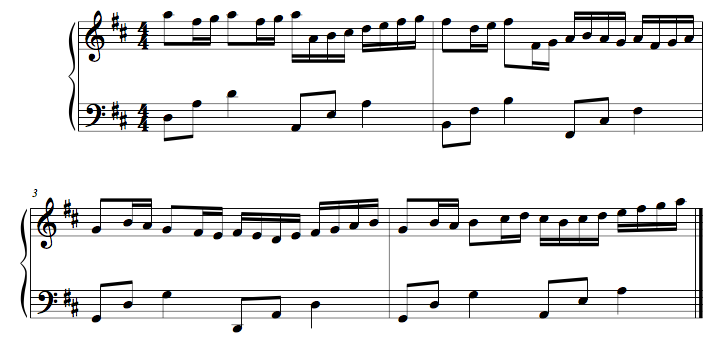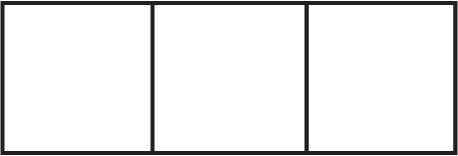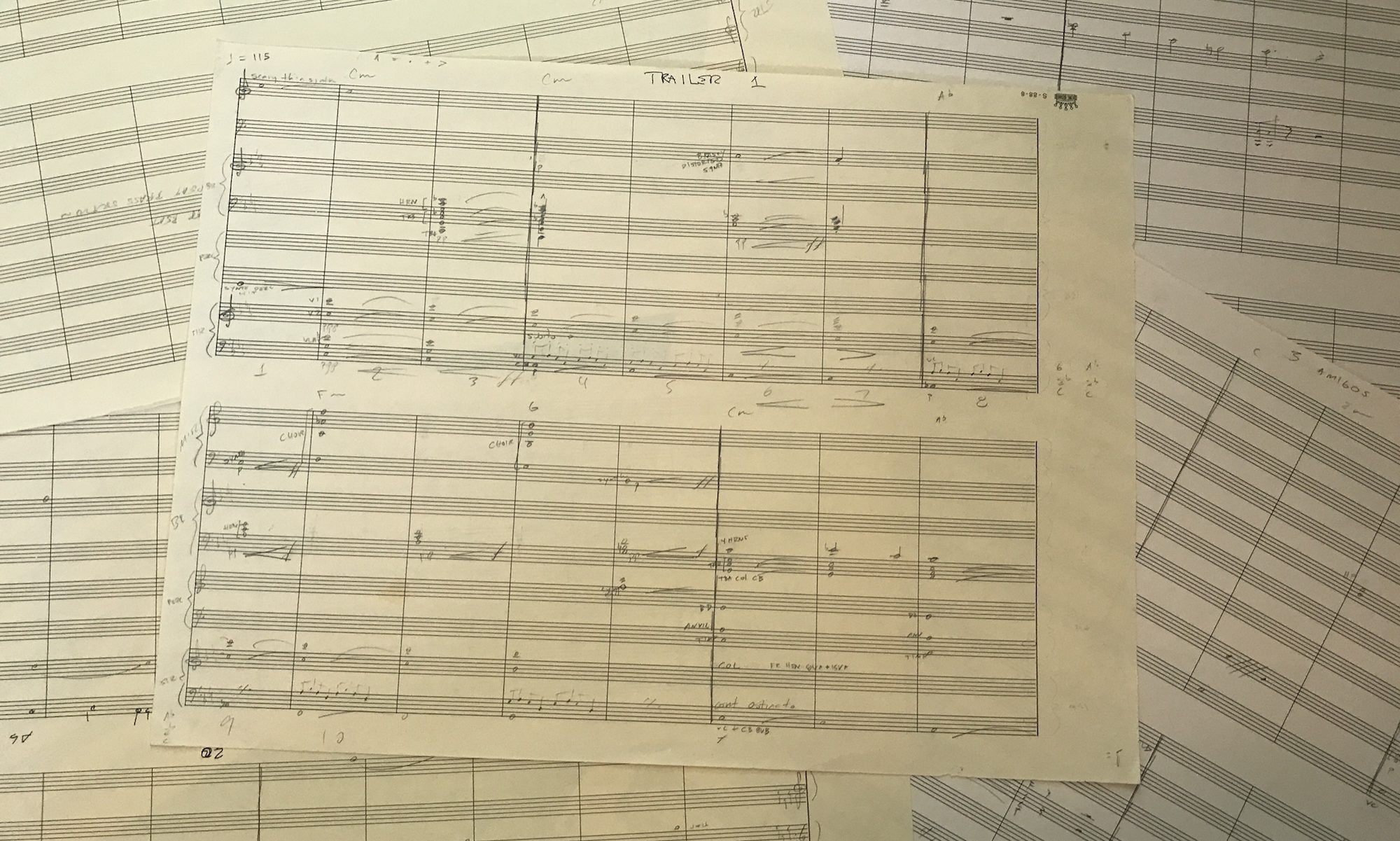5-11-20 Write a melody. Follow the melody formula as outlined in the book. The short version can be found in the appendix. You MUST use the same chords as last week. You MUST create a chord outline. Your chord tones MUST move to the next logical chord tone using correct voice leading. Scale tones will follow the chord tones. Do not jump away from a chord tone as this would create an ESCAPE TONE. Always favor neighbor tones and passing tones. For each non harmonic tone you use, know clearly how it is attached to the chord tones before and after it. If you are unsure how your non-harmonic tones are attached to chord tones, there is likely a problem. Stick to major and minor triads and avoid 7ths for the time being.
5-4-20 Pick 4 numbers between 1 and 6. These will form the 4 chords of your harmony. Determine the correct voiceleading. Choose one of your ostinatos. Repeat it over the harmony. Keep the notes in the same position on the staff, only moving the chord tones in the ostinato as needed to accomodate the harmony. Pick any key you want. Repeat twice for a total of 8 bars. If you want to explore, make two pieces.
4-27-20 Write more ostinatos. Create 8 different ostinatos. Each one will last no longer than a quarter note duration. Each one should have melodic outline of two chord tones. The rhythm is moveable meaning if you need to squeeze more notes in you can. Avoid “chord skips”. Ex don’t jump from a C note up to a G note. Each should either be 4 sixteenths long, or an 8th and two 16ths. Try to focus on neighbor tones passing tones, and repeated tones.
8-30-18 Transcribe The Star Spangled Banner
8-23-18 Listen to Deck the Halls on Youtube:
Deck The Halls
Using your instrument, listen to the piece and dictate it on music paper. Skip the intro. Write the melody only. Try to get the rhythm and notes correct.
8-16-18 Compose four measures of counterpoint with two opposing lines.
- Choose key, tempo, meter
- Choose harmony and voice leading
- For each voice
- Choose a form
- Choose a rhythm
- Chose a contour
- Add NH Tones
- Combine to form melody.
Sing the melody without using an instrument. You may choose a single reference tone from your instrument but that is all.
8-9-18 Compose two measures of counterpoint with two lines. For each line 1) choose a rhythm 2) choose a contour 3) add non harmonic tones. Do not use an instrument. Use pencil and paper only. Prepare to sing what you wrote.
8-2-18
Using two patterns from this list:
3 3 2, 3 2 3, 2 3 3
Concatenate them to form one large 16 beat pattern. Using non-pitched percussion only first lay down a straight non-syncopated rhythm. Then lay down a syncopated rhythm using the pattern you created ONLY emphasizing the first note from each group. Then, add another syncopated layer emphasizing the first TWO notes from each group. Finally add a third syncopated layer emphasizing all three notes from each group (truncate if only two notes in the group). Remember to accent the first note in each group.
7/26/18 Using non pitched percussion only, compose a piece using syncopation. Start with 4/4 time. First, compose a straight (non syncopated) rhythm to emphasize the beat. Next, using the pattern 3 2 3, compose a syncopated part. Finally, using the same 3 2 3 rhythm, compose a second syncopated part, but this time with more notes.
7/19/18 Analyze the solo from Pachelbel’s Canon. Identify all chord tones and mark them CT. For non-harmonic tones write NT for neighbor tone, PT for passing tone, or NH if neither.

Now, using the key of Ab Major, you will use a new harmony of I, IV, ii, vi, V, I, ii, V. This translates to Ab, Db, Bbm, Fm, Eb, Ab, Bbm, Eb. Determine the correct voice leading for these chords. Now adapt the melody to the new chords. You will use Ab as your starting pitch. The rhythm must match exactly, and the contour should be as close as possible. DO NOT try to attach your notes to the same chord member as the original unless absolutely necessary. This is incorrect voice leading. For example, if on a particular note the original melody uses the 3rd of the chord, you should ONLY use the 3rd of the chord if the voice leading is correct.
7/12/18 Analyze the solo from Pachelbel’s Canon. Write a new piece using the same outline in the following way. Pick a key. Roll a six sided dice eight times to create a harmony with 8 chords. Determine all the chord tones in the original. For all non-harmonic tones, determine whether they are passing tones or neighbor tones. Now in your new pieces, recreate the contour of the original chord tones and fill in the non-harmonic tones in the same way as the original.
6/28/18
Read the chapter in the book on writing Sections.
Choose a form for your section from the list of forms.
For each phrase in your section, compose a phrase using the instructions on How to Write a Melody, which also uses the list of Forms.
Assemble the phrases into a 4 phrase section.
6/14/18
Read the chapter in the book called Flying Under The Radar. Write a 16 measure long piece which uses the techniques discussed.
5/10/18
Exercise: Cycling
Cycling 1
Choose a rhythmic pattern that is three beats long. It should contain a strong beat. It should also contain at least one rest.

Now, in 4/4 time repeat your pattern twice. Use a quarter note duration for each beat of your pattern. ONLY use the note middle C.

Now add two beats worth of makeup material by truncating your three note pattern. Do this to complete the measure and get back to the downbeat of the next bar.
Cycling 2
Choose a rhythmic pattern that is three beats long. It should contain a strong beat. It should also contain at least one rest.

Now, in 4/4 time repeat your pattern four times. Use an eighth note duration for each beat of your pattern. Add two beats worth of material at the end to fill up the measure. ONLY use middle C.

Cycling 3
Use the following rhythmic pattern:

Use an eighth note resolution for each beat.
Repeat the pattern twice. Only use the note middle C. However, place an accent mark over the strong beat in each group. Accents look like this:
>
Add a quarter note worth of material to fill up the measure by truncating your three beat pattern.
Repeat the material exactly in the second bar.

Cycling 4
Use the following rhythmic pattern:

Use an eighth note resolution for each beat.
Use a C major arpeggio with the following contour:

Repeat the pattern twice.
Add a quarter note worth of material to fill up the measure by truncating your three note pattern.
Repeat the material exactly in the the second bar.

